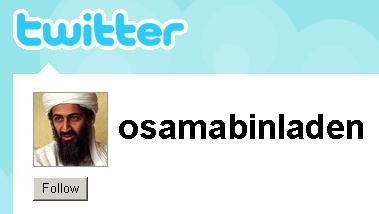I was amused to read that a draft Army intelligence report identified micro-blogging service Twitter as a potential tool for terrorists. On the other hand, it’s regrettable that this terrorism mania persists to foster this kind of report and media attention. There’s no distinct terror threat from Twitter. (Do check out the send-up of an Osama Bin Laden Twitter feed by clicking on the image.)
Sure, it’s possible that terrorists could use Twitter, just like it’s possible with any communications medium. Twitter is right up there with telephones, pen and paper, email, SMS, and smoke signals as a potential tool for terrorism. Each of these media have different properties which make them more or less susceptible to use for wrongdoing — and more or less protective of legitimate privacy for the law-abiding.
Like most common digital communications, Twitter is a pretty weak medium for planning bad things. Copies of every post are distributed far and wide — and all “Tweets” are housed pretty much permanently by a single organization.
If you want to get caught doing something wrong, use Twitter to plan it.
Securing against terrorism is hard because terrorists don’t wear uniforms or occupy territory. Their tools are our tools: sneakers, sandwiches, credit cards, cars, steak knives, box cutters, cameras, cell phones, driver’s licenses, Web sites, Napster, Friendster, Facebook, spinach. The list goes on and on and on.
(Yes, spinach — it grows terrorists’ muscles.)
The problem is determining what things in our society have a proximate relationship to terrorism that is greater than their relationship to all the good things we do with them. Box cutters were integral to the 9/11 attacks, but they are used by millions of people every day for wonderful purposes, so we haven’t pursued restrictions on, or monitoring of, box cutters (beyond airplanes, of course). Highly enriched uranium can be used to do a lot of damage. There is exceedingly little chance of it being used by terrorists, but it’s prudent to pursue controls on this material and monitor for peoply trying to acquire it.
Twitter and other digital media are used billions of times a day for all the good things law-abiding people do. There is also a small chance that they’ll be used for wrongdoing, and we have rules about what to do when that chance arises. Alas, Supreme Court cases under the Fourth Amendment are a little too permissive these days.
The chance of Twitter being used by terrorists (real ones, serious ones) is very small and not newsworthy. We’re all relatively inexperienced with the security dilemmas created by terrorism, and it’s appropriate to give a brief thought to how all the implements and infrastructure in society might be used to do damage. In summary, the production of a report on Twitter terror is just shy of silly. The media attention paid to the question: fully silly.


 The Technology Liberation Front is the tech policy blog dedicated to keeping politicians' hands off the 'net and everything else related to technology.
The Technology Liberation Front is the tech policy blog dedicated to keeping politicians' hands off the 'net and everything else related to technology.